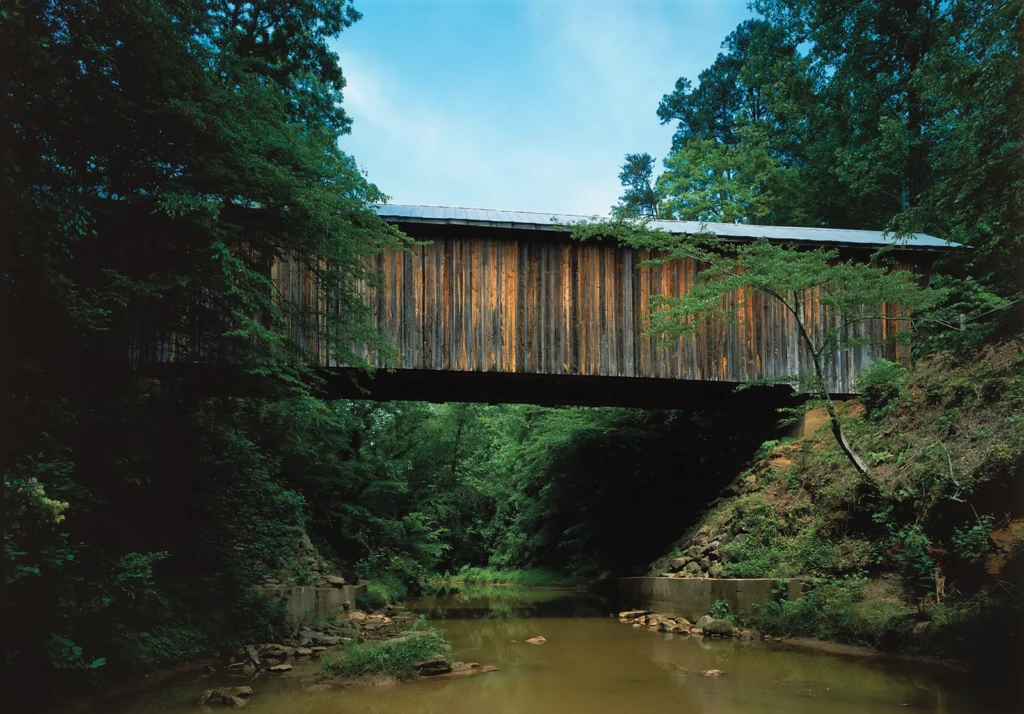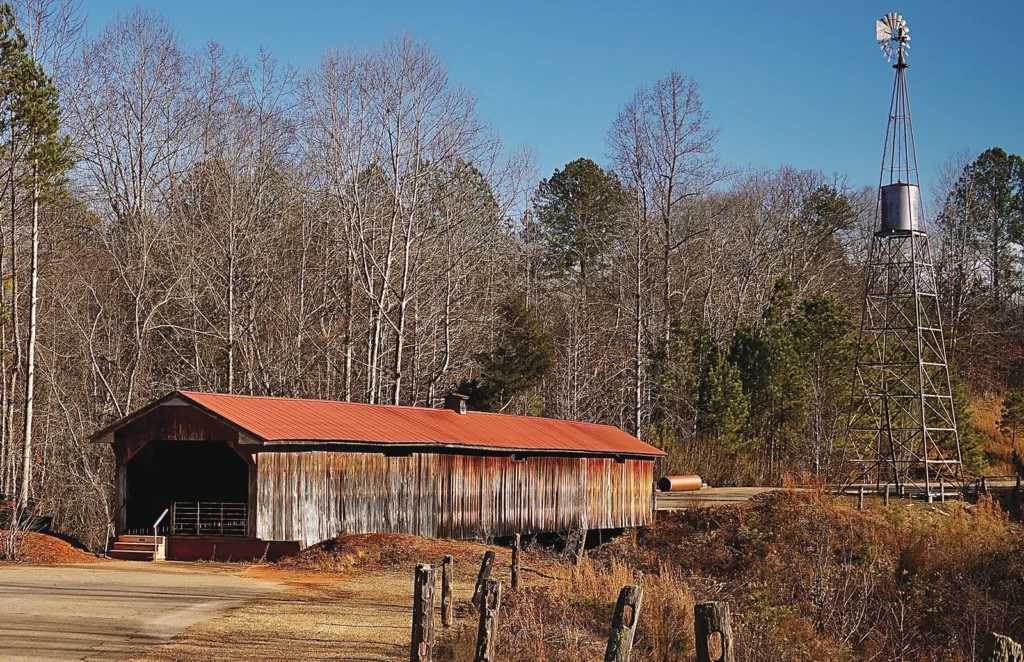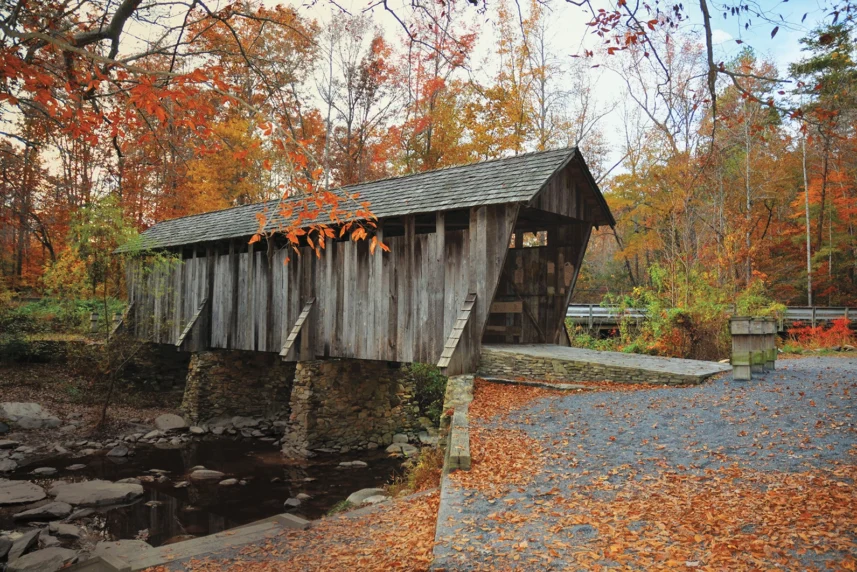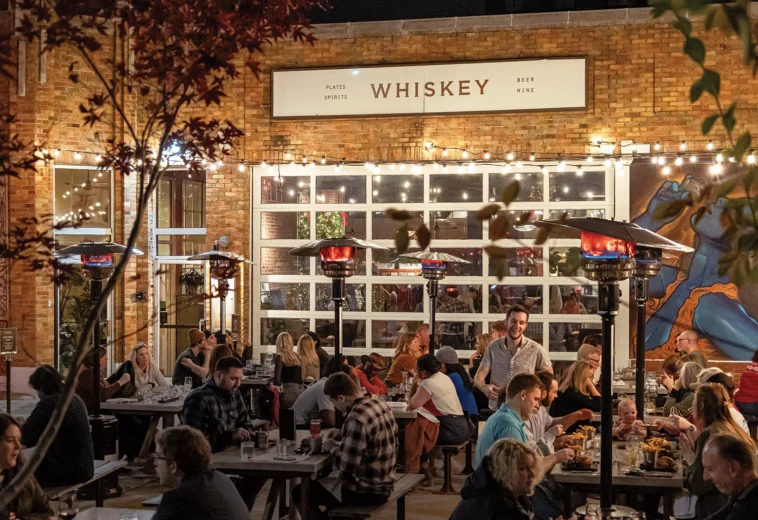Article:
BY ANITA B. STONE
Covered bridges remind us of the past—a time when people traveled by horse and buggy or on foot to reach destinations like the general store, the millpond or the county blacksmith; a time when children skipped rocks across creeks and rivers, and when cowbells rang to announce dinnertime.
Many covered bridges were built in North Carolina during the 19th and early 20th centuries. Over the years, however, covered bridges became obsolete—in part because engineers began making trusses, the systems of beams that hold many bridges together, from metal rather than timber, which meant the bridges’ substructures no longer needed to be protected from water.
Covered bridges also only offered single lanes, had low width and height clearance, and often could not support the heavy loads of constant traffic. Many of their stone foundations began crumbling with age. Their remnants can be found today.
A few North Carolina covered bridges remain standing, however—restored as national landmarks and as part of North Carolina’s historical legacy.
Pisgah Covered Bridge
Built in 1911, the Pisgah Covered Bridge, located in Randolph County, is a popular tourist attraction. At 54 feet long, the bridge crosses the West Fork Branch of the Little River within the Uwharrie National Forest. It was added to the National Register of Historic Places in 1970.
The bridge was privately built from white oak and pine by J.J. Welch (rather than, like most North Carolina bridges at the time, being funded by the county) at a cost of $40. According to the Randolph County Public Libraries’ local landmark designation report on the bridge in 2004, local citizen Claude Morris reported that he was standing nearby watching when Matthew Cagle, the first person to cross the bridge, drove his wagon team across it.
“Are you sure?” asked the person interviewing Morris. “That bridge is over 90 years old! How old do you think I am?” Morris replied.
The bridge was washed away by a flood in 2003, but the community was able to salvage about 90% of the materials from the original structure, and the bridge was restored the following year.
Since 1998 the North Carolina Zoo Society has collaborated with the North Carolina Department of Transportation, Piedmont Land Conservancy and the LandTrust for Central North Carolina (now called Three Rivers Land Trust) to maintain the bridge.

Bunker Hill Covered Bridge
The Bunker Hill Covered Bridge in Catawba County remains a historically unique example of a civil engineering marvel in North Carolina. It was designated as a National Civil Engineering Landmark by the American Society of Civil Engineers in 2001 and added to the National Register of Historic Places in the same year.
The Bunker Hill Covered Bridge was part of Island Ford Road (originally a Native American trail) built over Lyle Creek in 1895 by Andrew Loretz Ramsour. It was named after nearby Bunker Hill Farm, which had been in operation since the early 1800s. (Indeed, it was built because Catawba County commissioners had taken action against Bunker Hill Farm for improperly maintaining its bridge.) The historical significance of the Bunker Hill Covered Bridge is its extraordinary use of a wooden lattice truss designed by Herman Haupt.
In 1839, Haupt, a Pennsylvania Railroad assistant engineer (who would eventually become a Union Army general in charge of military railroads during the Civil War) patented a bridge construction technique called the Haupt truss, which was used exclusively by Pennsylvania Railroad between 1851 and 1861. Ramsour utilized a modified version of this truss in the construction of his bridge. Bunker Hill is one of only two remaining bridges in the U.S. built on modified versions of Haupt’s truss system. According to historian Brian J. McKee, Bunker Hill is North Carolina’s only remaining true wooden truss bridge.
The bridge’s 91-foot-long roof was added in 1900. In 1923, the original wooden shingle roof was replaced with a tin roof to protect the timbers from the weather.
In 1985 the Bolick family members, who then owned the bridge, donated it to the Historical Association of Catawba County, which owns the bridge today. The association restored the bridge in 1994. David Fischetti, the consulting engineer for the restoration, initiated the bridge’s designation as a national landmark.
Today, the renovated bridge is no longer in use for vehicles. Pedestrians, however, may enjoy a nostalgic stroll through this unique piece of North Carolina history.

Ole Gilliam Mill Park Covered Bridge
Unlike the other bridges covered here, today’s Ole Gilliam Mill Park’s covered bridge is not a historic structure, but at 140 feet in length, it is considered to be the longest covered bridge in North Carolina. The bridge is part of Ole Gilliam Mill Park, a faithful reproduction of a historic mill in Sanford.
Stephen Henly built the original Ole Gilliam Mill in 1850. In 1870, he sold it to Alexander McIver, and in 1890 the Gilliam family purchased the land. The mill was washed away by a flood in 1928.
In 1979 a reproduction of the mill was completed, constructed by Worth Pickard and many friends who worked feverishly on weekends. They obtained working parts from old mills throughout the Southeast. In 2000 the Pickard family donated the mill and land, including the existing buildings and relics, to Ole Gilliam Mill Park, which is currently run by a board of directors.
The current day Ole Gilliam Mill Park Bridge was built in the early 2000s and crosses Pocket Creek. With the distinction of being the longest covered bridge in North Carolina, the Ole Gilliam Mill Park Covered Bridge is found across the road from an old millpond just outside of Sanford. This bridge is open for pedestrian traffic, and visitors can enjoy strolling through Ole Gilliam Mill Park on the other side.
WHERE TO FIND THEM
• Pisgah Covered Bridge
6925 Pisgah Covered Bridge Road, Asheboro
Open to the public daily, 7 a.m.–7 p.m.
visitnc.com/listing/tqRA/pisgah-covered-bridge
• Bunker Hill Covered Bridge
4160 U.S. Highway 70, Claremont
Open dawn to dusk daily
catawbahistory.org/our-sites/bunker-hill-bridge
• Ole Gilliam Mill Park Covered Bridge
4718 Carbonton Road, Sanford
Open to pedestrian traffic daily from dawn to dusk
olegilliammill.org



